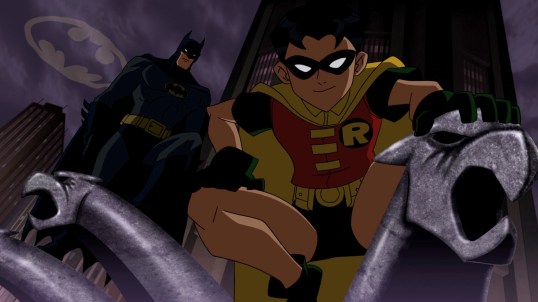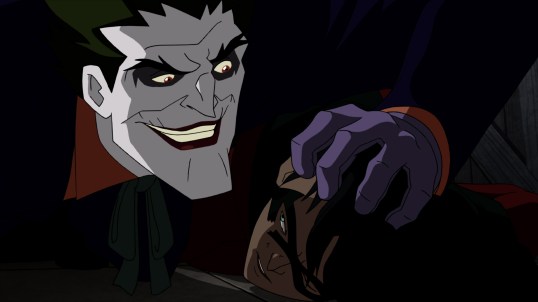I haven’t liked a lot of Judd Winick’s superhero work. And that’s weird because I thought Pedro & Me was a heart-rending portrait of his friendship with his former Real World housemate, enjoyed his Barry Ween: Boy Genius series as manic and madcap fun and dug the depth he showed on his underappreciated Vertigo series Caper. I figured he could use those same skills to infuse the super-powered characters he’s touched with stronger emotional dynamics and faster pacing. But—and maybe it’s just me—his tenure on Batman, The Outsiders and other books have generally felt too self-aware and choppy for me to really enjoy.
So, consider my amazement at being completely drawn in by Under the Red Hood.
[vodpod id=Video.4159859&w=425&h=350&fv=]
The new movie adapts some of Winick’s Batman storylines–two volumes of “Under the Hood”– with other events further back in Bat-continuity, shown in “A Lonely Place of Dying.” The story deals with the connection between a new person adopting the Red Hood identity used by various Gotham City criminals and Jason Todd, the boy who was the second Robin until he was brutally beaten up and blown to bits by the Joker. The new Red Hood upsets the balance of power in Gotham, drawing out Batman and Nightwing to try and shut him down.
Surprisingly, the same things that have turned me off of Winick’s Batman runs make Under the Red Hood distinctive and zippy. Because things are constantly in motion on the screen, the snarky banter doesn’t feel like it’s holding things up, like it can on the page. The stylized dialogue that can feel too self-aware in comics makes the characters feel more syncopated , like they’ve each tied into a greater rhythm. The Joker in Under the Red Hood–voiced by John DiMaggio– feels a little rougher-hewn than interpretations in other animated Bat-movies. Overall, the film’s grimmer and more brutal than any Bat-flick in recent memory but never feels egregious about the violence. The expository stretches in the movie are particularly sharp, dumping a lot of background info speedily and efficiently. In the off chance that you don’t know who Amazo, Nightwing and Black Mask are, you find out within seconds without slowing down the pace.
Of course, Winick’s not on his own here. Warner Bros. Animation has long been setting the standard for top-shelf voice work in their productions and that tradition continues here. Neil Patrick Harris as Nightwing brings just the right mix of tension and devotion to his scenes with Bruce Greenwood’s Batman. And, as the Dark Knight, Greenwood evinces the necessary toughness but still communicates that there’s actual emotion churning beneath the cowl. Black Mask, the ruling Gotham crimelord in Under the Red Hood, Wade Williams chews the scenery with believable menace. Some lines the Red Hood utters might come off hollow or corny in hands of lesser actors, but Jensen Ackles always makes the guy sound like a force to be reckoned with.
Brandon Vietti’s direction shows a shrewd touch, knowing when to let certain moments linger and when to push the plot forward quickly. The art direction and animation makes this version of Gotham feel sharp and modern, and the action sequences pop with inventive chases and impressive fight scenes. There’s a teensy bit of techno that peeks through the symphonic soundtrack at times, but that just winds up making the proceedings feel, again, current.
The high production values of the DC Universe Animated projects serve to bring out the action and emotion. It’s a film that does the unenviable job of pleasing old and new Bat-fans alike. Under the Red Hood elevates the source material and hits on the Batman/Robin/Joker relationship in ways that reminds you why each character matters.
Official Techland Score: A-



